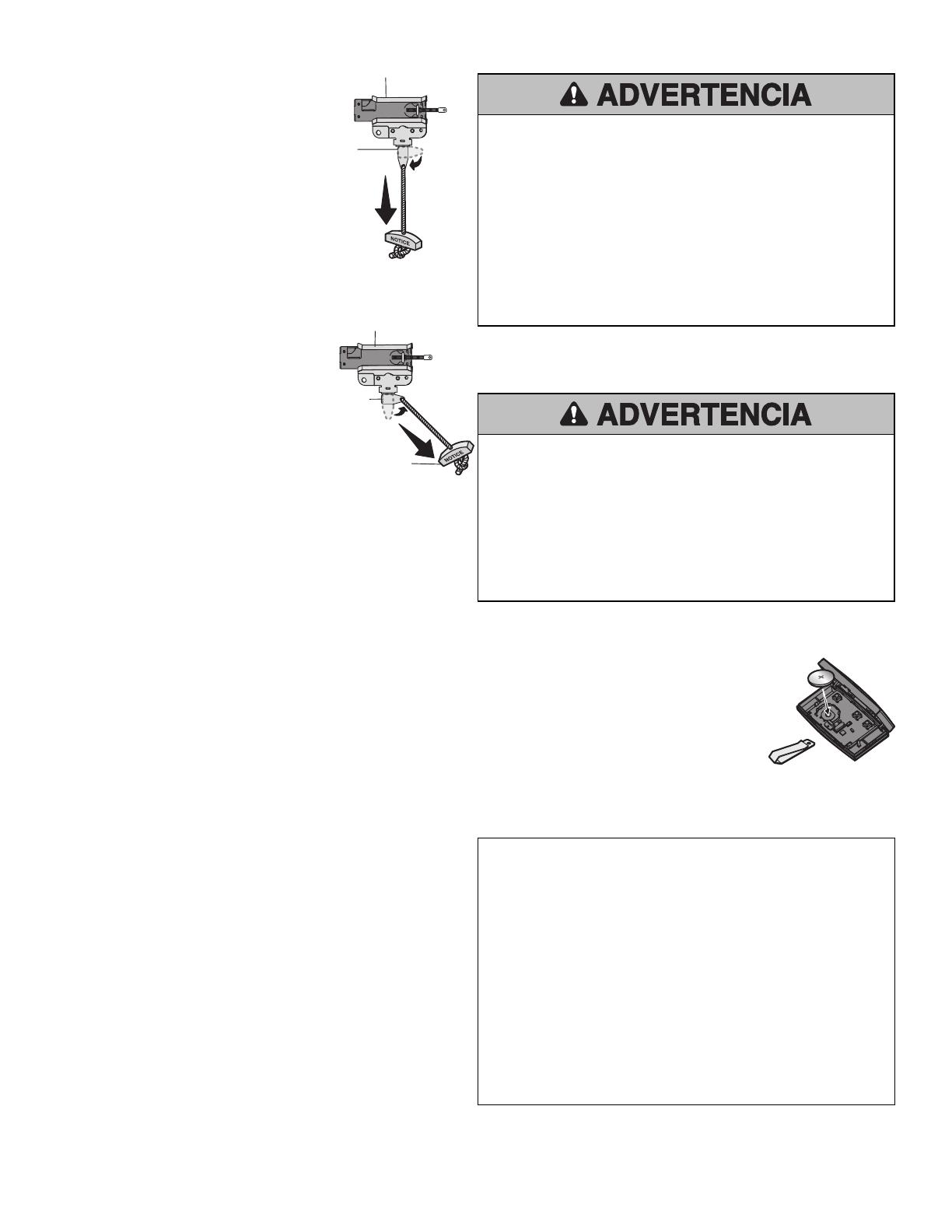
PARA ABRIR LA PUERTA MANUALMENTE
Brazo de
liberación
del carro
(posición de
desconexión
manual)
Manija de
liberación de
emergencia (Jalar
hacia abajo y atrás en
dirección al abre-puertas)
Posición de bloqueo
(posición de desconexión
manual)
Para volver a conectar
Brazo de
liberación
del carro
Carro
DESCONECTE EL CARRO
1. Si es posible, la puerta se debe cerrar
completamente.
2. Jale la manija de desenganche de
emergencia para que el brazo de
desenganche del carro quede en posición
vertical. A continuación, la puerta se
puede subir y bajar manualmente siempre
que sea necesario.
VOLVER A CONECTAR EL CARRO
1. Jale la manija de desenganche de
emergencia hacia el abre-puertas de
garaje para que el brazo del carro quede
en posición horizontal. El carro se volverá
a conectar en la próxima operación de
movimiento hacia ARRIBA o hacia ABAJO,
ya sea manualmente o usando el control
de de la puerta o el control remoto.
Para evitar la posibilidad de una LESIÓN GRAVE o LA MUERTE si la puerta del
garaje se cae:
l De ser posible, use el desenganche de emergencia para soltar el carro
SOLO cuando la puerta del garaje esté CERRADA. Si los resortes están
débiles o rotos o si la puerta está desequilibrada, podría abrirse y caer
rápida y/o inesperadamente.
l NUNCA use la manija del desenganche de emergencia a menos que la
entrada al garaje esté libre de obstrucciones y no haya ninguna persona
presente.
l NUNCA use la manija para tirar de la puerta para abrirla o cerrarla. Si el
nudo de la cuerda se suelta, usted podría caerse.
LA BATERÍA DEL CONTROL REMOTO
Para evitar posibles LESIONES GRAVES o la MUERTE:
l NUNCA permita la presencia de niños cerca de las pilas/baterías.
l Si alguien ingiere una pila/batería, llame al médico de inmediato.
Para reducir el riesgo de incendio, explosión o quemadura química:
l Reemplace las pilas solo por pilas tipo botón de 3V CR2032.
l NO recargue, desarme, caliente por encima de los 100 °C (212 °F) ni
incinere la pila o batería.
1
2
3
Para reemplazar la batería, abra la caja
primero por el medio (1), luego por cada
lado (2 y 3) con el broche para visera.
La batería de litio debe producir energía durante 3
años.
Para cambiar la batería, use el clip del visor o un
desarmador para abrir la caja, tal como se
muestra. Coloque la batería con el lado positivo
hacia arriba (+).
Reemplace las baterías solo por baterías tipo
botón de 3V CR2032. Deseche las pilas usadas en
forma adecuada.
MANTENIMIENTO DE SU ABRE-PUERTAS DE GARAJE
PROGRAMA DE MANTENIMIENTO
Cada mes
l Haga funcionar la puerta manualmente. Si está desequilibrada o se atasca,
llame a un técnico capacitado en sistemas de puertas.
l Verifique que la puerta se abra y se cierre completamente. Ajuste si es
necesario, consulte la página 29.
l Pruebe el sistema de reversa de seguridad. Ajuste si es necesario, consulte la
página 31.
Cada año
l Ponga aceite en los rodillos, los cojinetes y las bisagras de la puerta. El abre-
puertas de garaje no necesita lubricación adicional. No lubrique los rieles de
la puerta.
ADVERTENCIA: Este dispositivo cumple con la Parte 15 de la reglamentación de la FCC y los estándares RSS exentos de
licencia de Industry Canada. La operación está sujeta a las siguientes dos condiciones: (1) este dispositivo no puede
causar interferencia perjudicial, y (2) este dispositivo debe aceptar cualquier interferencia recibida, incluyendo la
interferencia que puede causar una operación no deseable.
Cualquier cambio o modificación no expresamente aprobada por la parte responsable del cumplimiento podría anular
la autoridad del usuario para operar el equipo.
Instalar este dispositivo de manera que quede una distancia mínima de 20 cm (8 pulg.) entre el dispositivo y los
usuarios/transeúntes.
Este equipo ha sido verificado y cumple con los límites para un dispositivo digital de Clase B, conforme con la Parte 15
de las normas de la FCC y el estándar ICES de Industry Canada. Estos límites se establecen para brindar un nivel
razonable de protección contra interferencias perjudiciales en instalaciones residenciales. Este equipo genera, usa y
puede emitir energía de radiofrecuencia. Si no se instala y utiliza de acuerdo con las instrucciones podrá causar
interferencia con comunicaciones radiales. Aun así, no hay garantía de que no se produzcan interferencias en una
instalación particular. Si este equipo produce interferencia en la recepción de radio o televisión, lo cual puede
determinarse apagando y encendiendo la unidad, el usuario debe tratar de corregir el problema por medio de lo
siguiente:
l Volver a orientar o reubicar la antena receptora.
l Aumentar la distancia entre el equipo y el receptor.
l Conectar el equipo en una salida de un circuito distinto del circuito al que está conectado el receptor.
l Consultar con el distribuidor o con un técnico de radio/TV experimentado para pedir ayuda.
39































































































